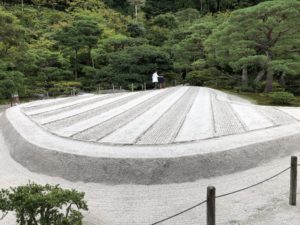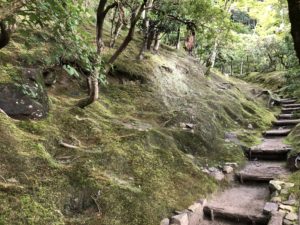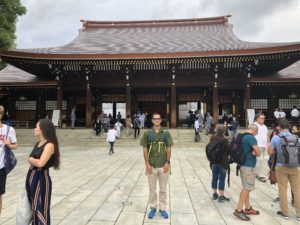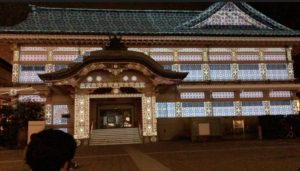Given that today started with transporting two 40 pound bags over 2 miles to my house, I couldn’t have imagined how it would end up!
After unpacking, lunch, and some shopping, I decided to head up to Ginkaku-Ji (the Ginkaku Temple). I figured, “I live right next to it, my building and neighborhood are named after it, so I might as well see it once.” I was expecting a traditional Shinto shrine like the Meiji Jingu that I had visited in Tokyo (picture below, from last week). What I didn’t realize is that Ginkaku-Ji is actually a Zen Buddhist temple! Beginning from the entryway and extending throughout the temple complex, there was a sense of intricate balance between the nature and human-made artifacts. Every time I re-looked at any part of the temple complex, I noticed another meticulously placed detail that I had missed: the rock balanced on two other rocks, the bamboo mats on the side of the stairway, the multiple geometric patterns in the raked pebbles. And at the top, there was an amazing view of the city!
After leaving Ginkaku-Ji, I still had 1-2 hours before dinner. Much of my travel over the last few years has involved getting to one place, looking at a map, and deciding where to go next. In that spirit, I decided to take Philosopher’s Path (a river-side path that starts at Ginkaku-Ji) down to the Okazaki Park, and then get dinner in that area. My heuristic for making that decision was to maximize my time with the river and greenery (already my favorite part of Kyoto)!
As with any decision, there were multiple times when I considered deviating from that plan — I considered stopping by an interesting store, or eating in a cafe along the way, or leaving after merely seeing the park. I’m so glad I didn’t! Because as I started walking through the park, I noticed a ton of white tents. Close inspection revealed a street fair of some sort! Every white tent was selling different types of food, from sushi to yakisoba to takoyaki to udon. On top of that, there was a musician playing the Shamisen, a traditional Japanese 3-stringed plucked instrument. And the best part? A quick scan of the crowd revealed people that looked local and not like tourists. I had coincidentally happened upon an event that only locals were privy to!
The main draw of the fair was a Projection Mapping competition put on by the Rohm Theater Kyoto. I had never heard of Projection Mapping before, and was completely mind-blown! Projection Mapping involves projecting a video (in this case, along with sound) onto a complicated 3D object (in this case, a Japanese-style nearby building). The projections alone were marvelous. But the ways in which they interacted with the building was simple spectacular. I saw the same building being transformed from the site of a circus to a Persian/Islamic style mosaic building to an artists canvas. The works had to interact with the 3-dimensionality of the building, the colors of the building, and the shadows cast by the building, not to mention the music and overall theme of the piece. I can’t begin to imagine how long it took the artists to create their final works.
And the best part of an already-fabulous day? Near the Projection Mapping competition, I happened upon a small gathering with live musicians performing traditional Japanese songs. One performer was playing a bowed string instrument that sounded beautiful and reminded me a lot of the violin (there were also certain elements of the playing style that reminded me of North Indian Classical Music). Afterwards, I went up to ask her more about the instrument (something that took lots of mental preparation, and that I was afraid of letting slip through my hands due to a lack of courage and less-than-ideal confidence in my Japanese). After inquiring about whether there were ways for me to learn the instrument, it turned out that she teaches it (called a Niko) at a local music school! I took her contact information, and will definetely be reaching out. I’m super glad I had been primed with Fulbright Japan’s director Matthew Sussman’s advice to “jump at opportunities that present themselves” and to “be open and ask people about the types of things [I] want to do.”
And to cap it off, I walked 3 miles home, much of it along the river. Not only does the part of Kyoto I am in (which is near the Kyoto University main campus) have a ton of natural beauty, but it is also quite well-lit and feels super safe. I’m looking forward to spending 10 months here!
Now, the million-dollar question is: how do I find more of these local, non-touristy gatherings? I guess I have 10 months to find out! 🙂






What a marvelous day! And kudos to you for leaping in & embracing your surroundings & place! Sounds like you’re in a great part of town & are making the most of it. I love that you screwed up the courage to speak to the musician (in Japanese!) and will take classes! And beautiful web page. Look forward to reading about your adventures!
Live in the moment and make the most of the opportunities in your path! ❤️
Amal, thank you for sharing your insights and details of your adventures. There are so many fascinating lenses to use as you explore the intricacies of this country. Keep your mind open and go off the beaten path—that path had been someone else’s experience—and forge your own way..
Hi Amal,
From my 2 years of stay in Japan in early 80’s , working with Kobe Steel Ltd., my recollections of this beautiful country are:
– Subtle fusion of old culture and modern amenities.
– Politeness and humility in Japanese people.
– Work environment where every one is equal be it your manager/chief/director. No personal cabin. Every one’s desk is in big open area. Everyone eats same lunch provided by company.Every one wears same company jacket.
– There are no underdogs ! Everyone is treated with respect. Even an intern is trained with patience and care.
– Japanese engineers have tremendous patience. When an important technical letter comes from a foreign client, I have
seen them spending whole day translating in Japanese-read it to understand the contents- prepare a reply in Japanese- translate it into English- then give it to the Boss’s secretary to type…
-Workaholic… spend late hours in the office. Practically every evening after office, ‘happy-hour’ of drinking with colleagues where they vent out the day’s frustrations in the office etc. Japanese house wives would feel scared if husband comes home early thinking he may have been fired !
I am sure you will learn a lot and get good experience there for your future career. Keep an open mind and intermingle with colleagues and people in general. More than 30 years since I left Japan, but I still have good relationship with Hamamoto-san who was my senior at Kobe Steel.
Enjoy your stay and make most of it…
-Daada-
Sounds like a fantastic start! Good for you for venturing out and discovering cool things like this. Looking forward to more!